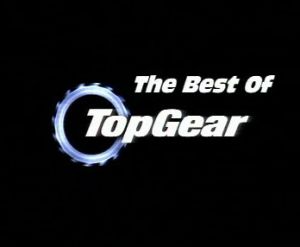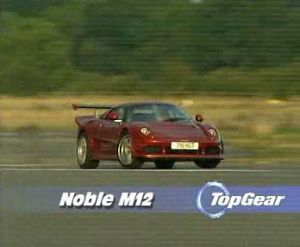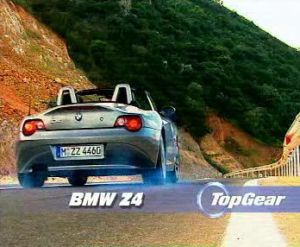Top Gear (2002 TV series)/Series 1/Best of Top Gear (26th January, 2003)
| Episode 11 (Best of Top Gear) | |
|---|---|
|
| |
| Prod. code | GFGA025E |
| No. | 560 (since 1977) |
| Runtime | 59:01 |
| Viewers | 2.82 million |
| Next ep. | Best of Top Gear #2 |
| Prev. aired | Series 1, Episode 10 |
| Airdate |
|
The Best of Top Gear aired on the 26th January, 2003. It was the eleventh episode of Series 1; the 560th episode overall. It was the 551st episode since Top Gear entered national broadcasting in 1978, and was the 1st programme to air in 2003 out of a total 27. The first best-of compilation of Series 1, it was also the show's first such compilation episode. The Best of Top Gear was originally broadcast in 576i at a 16:9 Widescreen aspect ratio on British television channel BBC Two. The episode was presented by Jeremy Clarkson, Jason Dawe, and Richard Hammond, alongside The Stig.
Synopsis[edit | edit source]
The Best of Top Gear was a compilation episode; as a result, all segments were those which had previously aired, albeit in an abridged form.
Superminis[edit | edit source]
Back in the 1980s, Hammond states, the most fun a driver could have was in a supermini, with the added benefit of the cars' low speeds preventing the driver from getting in trouble with the law. Since then, superminis have got larger, better equipped and faster, which begs the question as to whether or not a simple, fun-to-drive supermini still exists in 2002. A year earlier, a third of all new cars sold[1] in Great Britain were superminis, and Richard Hammond has decided to see if there is any to fun to be had with the current crop of these cars. To avoid misrepresenting the chosen models, Hammond has gone for the mid-range 1.4 litre petrol options of each respective car. The first car Hammond reviews is the Ford Fiesta. Hammond remarks that because it's a Ford, it has all the interior kit a prospective owner would want, but he lambasts the design of the interior, which he feels is one of the ugliest ever made. The driving feel of the car is also good, and the rear seat space is an improvement over the car's predecessor. At a price of £10,995, the car does come with air conditioning as standard, but fails to innovate both inside and outside. The Citroën C3 is next, and Hammond is more forgiving with this car, praising its funky looks, durability and comfortable ride, as well as its "personality". He suspects that although the interior quality is not up to the standard of the C3's rivals, the rest of the car will be markedly more robust and last in the long run. Conversely, Hammond feels that certain interior aspects were over-engineered for their roles, such as the air vent covers and door handles, and that like the Fiesta, stays too rooted in tradition to move superminis forward.
After the Citroën comes the Honda Jazz, which Hammond opines has done exceedingly well with its interior space management, feeling more like a mini MPV than a supermini despite an outward appearance of the latter. However, in doing so, the Jazz is not as well-insulated as some of its rivals are, with outside noise being more apparent. To drive, the Jazz also feels top-heavy, and Hammond believes this is a necessary downside a customer must accept if they want space in a supermini. What Hammond considers to be the Honda's biggest downfall is its price, with a mid-range model costing £10,300, for which a CD player and alloy wheels do not come standard. The opposite is true for the Jazz's immediate Japanese rival, the Nissan Micra, which is loaded with standard-fitted gadgets. These include a "Happy Birthday" greeting beamed through the car's in-car-entertainment system, which Hammond feels is rather 'sad'. The Micra is built in Sunderland, the most quality control-obsessed car factory in Europe, and can be had with a CD player, alloys, and keyless ignition for less than the price of an sparsely-equipped Jazz. The car also has automatic windscreen wipers, reverse parking sensors and radio controls on the steering wheel, in addition to climate control. However, for all its positives, the car lacks the raw, gutteral feel of a 1980s supermini. For that, you'd want the MG ZR, which despite its low power output, comes standard with spoilers, spotlights and garish paint colours. Despite its basic 1.4 litre engine, the car provides 105 BHP to its rear wheels for just £10,000, which is far more than any of its rivals. It may be a Rover 200 underneath, which makes itself apparent through its outdated interior, but Hammond feels as though the car has earned its MG badge.
The ZR justifies these credentials by setting a very competitive lap time of 1:34[2] on a dry test track, 2 seconds faster than its closest rivals, although it is not specified which cars it beat. Once in the studio, it transpires that a Top Gear producer has purchased a Honda Jazz in the same colour as the one Hammond drove; Iris Red (though the colour itself is a metallic shade of bright pink). Hammond and Clarkson come to the conclusion that if one wants the most practical supermini for £10,000 to buy the Jazz in spite of its optional equipment and all the other shortfalls Hammond discussed, and if one wants a fun, cheap hot hatch oriented around performance, to seek out the MG ZR in spite of it being a spruced-up Rover 200.
Airing history[edit | edit source]
As Top Gear was not yet as successful as it would eventually become, this episode would only be broadcast once. In addition, after the later success of host James May, episodes from Series 1 would become undesirable and as a result, would be pulled from the BBC World Sales Catalogue after 2009. This was likely due to the fact there were now more than 100 other episodes available for syndication.
| Channel | Date | Time | Cut | Definition | Type |
|---|---|---|---|---|---|
 |
26th January, 2003 | 20:00 | Original | Standard | Premiere |
Preservation status[edit | edit source]
Due to the work of archivists, The Best of Top Gear can be watched in its entirety, albeit not at the original resolution, aspect ratio, nor bitrate. Otherwise, the episode would be considered lost media.
References[edit | edit source]
- ↑ BBC News - Business: UK car sales hit record.
- ↑ It's unknown where this lap time actually came from as Hammond does not mention it, however another ZR set a similar time of 1:33.9 during Series 2 and it may be this time a Wikipedia editor used, thus an incident of citogenesis.
[edit | edit source]
| |||||||||||
- Episodes presented by Jeremy Clarkson
- Episodes of Top Gear presented by Jeremy Clarkson
- Episodes of Top Gear (2002 TV series) presented by Jeremy Clarkson
- Episodes presented by Jason Dawe
- Episodes of Top Gear presented by Jason Dawe
- Episodes of Top Gear (2002 TV series) presented by Jason Dawe
- Episodes presented by Richard Hammond
- Episodes of Top Gear presented by Richard Hammond
- Episodes of Top Gear (2002 TV series) presented by Richard Hammond
- Episodes of The Best of Top Gear
- Episodes of Top Gear
- Episodes of Top Gear (2002 TV series)
- Eleventh Episodes
- Eleventh Episodes of Top Gear
- Eleventh Episodes of Top Gear (2002 TV series)
- Episodes which aired on 26th January
- Episodes of Top Gear which aired on 26th January
- Episodes of Top Gear (2002 TV series) which aired on 26th January
- Episodes which aired in 2003
- Episodes of Top Gear which aired in 2003
- Episodes broadcast in 576i
- Episodes of Top Gear broadcast in 576i
- Episodes broadcast at 16:9 Widescreen aspect ratio
- Episodes of Top Gear broadcast at 16:9 Widescreen aspect ratio
- Episodes broadcast on BBC Two
- Episodes of Top Gear broadcast on BBC Two
- Episodes of Top Gear (2002 TV series) broadcast on BBC Two
- Episodes of Top Gear (2002 TV series) that were pulled from air
- Found Top Gear (2002 TV series) media



